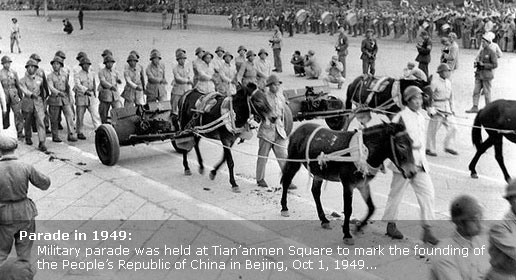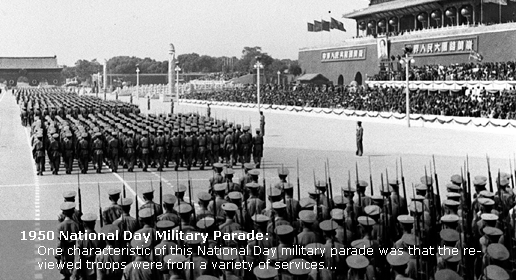60 People, 60 Stories
Singular solution
(China Daily)
Updated: 2009-09-30 07:41
It is known for having the most number of people, but not many are aware that China is also facing its first peak in a graying population.
|
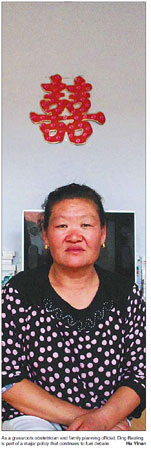 As a grassroots obstetrician and family planning offi cial, Ding Baoling is part of a major policy that continues to fuel debate. [China Daily] |
"People born in the baby boom after the founding of New China in 1949 are aging. A lot of them are parents of an only-child generation and don't live with their married children," says Fang Jiage, founder of the private and non-profit Hetong Senior Citizen Welfare Association and Charitable Foundation in Tianjin.
"The question now is: Who will take care of them, and how?"
A member of this approaching "gray wave" himself, Fang, 55, says that institutional facilities should play a bigger role in improving the quality of life of the eldery - and maintain their dignity at the same time.
When Fang set up Hetong's first retirement home based in an old hospital in Tianjin's suburb in 1994, almost all the institutions for the elderly were still government funded. These served the childless, disabled and mentally challenged.
As authorities boost the expansion of eldercare from families to social institutions, elderly residents today who are still capable of working and prefer to stay at home can begin to enjoy professional homecare services and support provided by neighborhood facilities as an alternative.
Fang's group also operates an old-age home in Beijing's Yuetan community under agreement with the area's neighborhood community. The institution has only 50 beds, while the neighborhood is home to 26,000 residents and nearly 12 percent of them are from empty-nest families.
The home's employees also provide homecare services like meals, haircuts, baths and company that are just a phone call away.
Pilot eldercare home services have already been rolled out in large, aging cities like Beijing and Shanghai. The municipal governments help pay for services by granting a monthly allowance of between 50 and 250 yuan to senior citizens who meet certain standards.
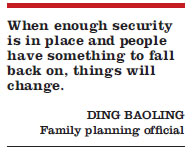
However, Fang warns that caretakers in the sector suffer from a generally low-level of professionalism. According to the China National Committee on Aging, the number of people working in old-age services hit 321,600 by the end of 2007. Less than one in 10 have the relevant professional qualifications.
"Other than that, we may need 10 million eligible caretakers to fulfill the duties of old-age care," he says.
Almost all of the caretakers at Hetong's five retirement homes are migrant workers.
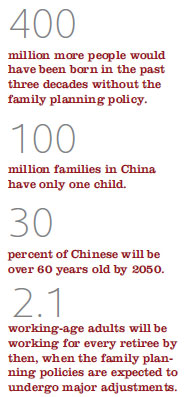
"They quit easily because their jobs are not taken seriously by many people. They shift to other professions that don't require such demanding skills and are much less tiring," Fang says.
The public needs to change its attitude toward the profession if they want to create a better living environment for the elderly, Fang says. He hopes that urbanities in their 40s and 50s who have been laid-off and are unable to find work can join the sector. He also encourages young people to carve a niche in old-age services and upgrade its overall management.
If so, they will form a crucial part of the country's efforts to accommodate the eldery. China's basic pension insurance system had benefited 219 million people by the end of last year.
The country has plans to expand the coverage of the elderly in its extensive countryside, which would particularly benefit those who are left home alone by their migrant children in the cities.
The government also plans to introduce a more flexible system, so that its 230-million rural migrant workers can enjoy retirement benefits even if they change jobs often.
Fang is also pushing for greater health insurance.
"People can save money for possible healthcare services when they are old," he says.
"The money can also be directed to helping other people. Such a system tends to benefit everyone."
Time line
Early to mid-1950s
The government prefers a large population amid recovery from decades of war and starvation.
1956
Premier Zhou Enlai suggests that health departments promote family planning nationwide except in regions inhabited by minority groups.
1957
Family planning measures proposed by Ma Yingchu are criticised as "anti-Party" and "anti-socialist".
1959-1961
Family planning is halted altogether amid unprecedented famines and political campaigns.
1962
The CPC Central Committee and the State Council release circular to promote family planning. Nonetheless, its measures are poorly implemented.
1966
Local family planning agencies are shut with the start of the "cultural revolution".
1967
Family planning agencies resume work.
1971
Full-scale family planning measures put in place, with slogans including "One child is not enough, two is just right and three is too much".
1973
A leading group on family planning is set up under the CPC Central Committee.
1979
The first batch of "only-child certificates" are distributed.
1980
The government begins to enforce the family planning policy.
2007
In all of China except Henan, the country's most populous province, couples who are both single children are allowed to have two children.
Now
Scholars call for readjusting the family planning policy to allow more children as the country ages.





